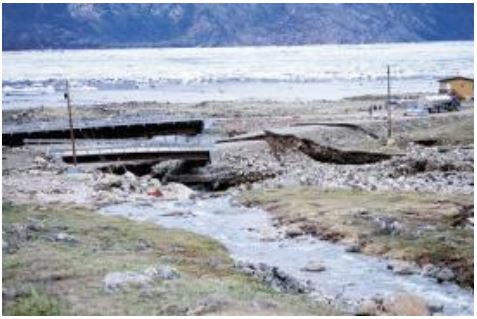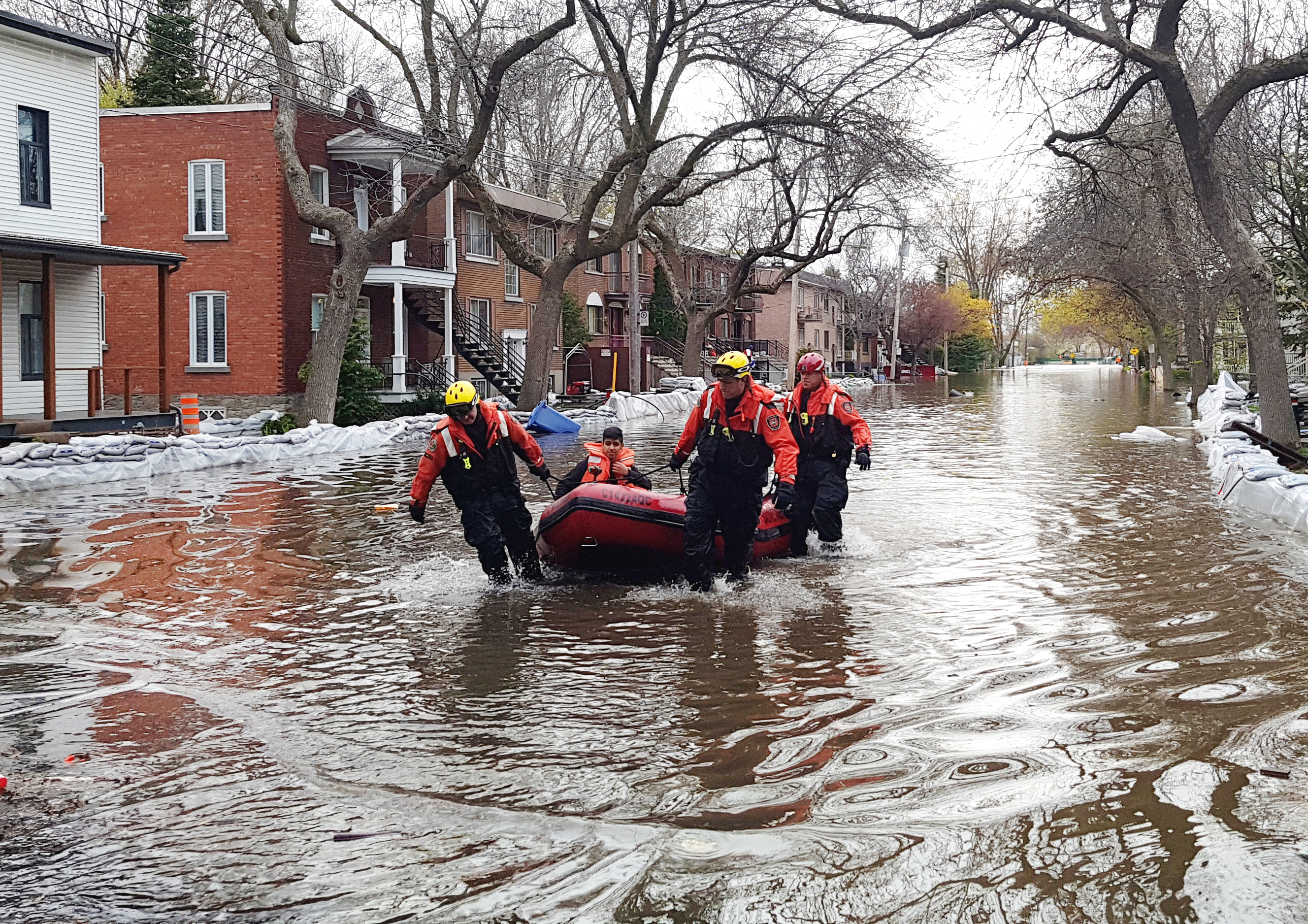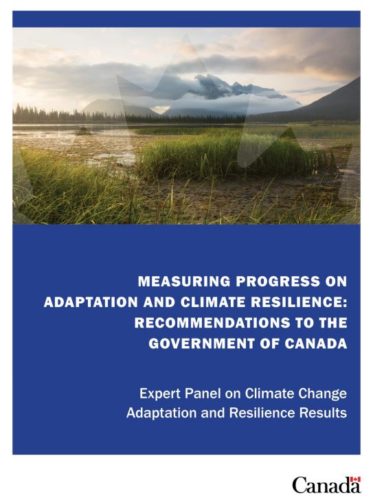It was announced yesterday that Canada’s Expert Panel on Climate Change Adaptation and Resilience had released its findings after being appointed in August 2017.
The report, Measuring Progress on Adaptation and Climate Resilience: Recommendations to the Government of Canada, addresses what is required to effectively manage climate risks across the country. To that end, the Expert Panel emphasized “coherence and high levels of coordination between actions that result from an understanding of Canada’s overall progress on adaptation and climate resilience.”
The result was 54 indicators that can be used to assess Canada’s progress. “Expert Panel members felt strongly that the indicators must show respect for, and take into consideration, scientific information and Indigenous Knowledge Systems in equal measure,” wrote Dr. Blair Feltmate, chair of the Expert Panel. “This philosophy was reflected in all discussions and meetings of the Expert Panel.”
The indicators were organized under five categorical frames, including protecting and improving human health; supporting vulnerable regions; reducing climate-related hazards and disaster risks; building climate resilience through infrastructure; and translating scientific information and Indigenous knowledge into action.
Contamination of water ranked high in the potential impacts on human health as a result of extreme weather events. Furthermore, the intersection of these concerns with vulnerable communities is highlighted. Much like the United Nation’s Sustainable Development Goals, the Expert Panel’s indicators consider the intersection climate risk factors and mitigation and sustainability actions.
The Expert Panel offers as example Pangnirtung, Nunavut. In 2008, a state of emergency was declared after the “town’s only bridge collapsed due to rapid permafrost thawing and erosion from floodwater.” The consequences were a bisecting of the community. In one half fresh water service and sewage removal were available; the other half was disconnected from these essential services, increasing the community’s vulnerability to water contamination.

“I sincerely thank the Expert Panel members for their time, energy, and dedication to this work,” said federal Minister of Environment and Climate Change, Catherine McKenna. “The information gathered during this process will be invaluable as we move toward a better understanding of how to measure Canada’s progress on adaptation and climate resilience.”
Water’s role in climate change and adaptation is highlighted in other areas, as well, such as indicator number twenty-three: Number of watershed or regional-scale water management plans incorporating future water supply due to climate change. The importance of this indicator is described through the potential outcome of drought, which can have “immediate and long-term consequences for the health and safety of Canadians.” And, despite not being an acute onset disaster, such as wildfire or flood, drought requires a similar emergency response as an acute disaster.
The panel’s findings are tinged with urgency. “It is essential that Canadians act now to adapt and build their resilience to climate change,” they write.
Below is the list of fifty-four indicators under their respective category of analysis. Each indicator is accompanied by a template containing its “rationale, contextual and baseline information, information on the relevance of the proposed indicator for Indigenous Peoples,” as well as other details, such as relevant publications. This can be found in the complete document.
Protecting and Improving Human Health and Well-Being
- Proportion of climate change vulnerability assessments that consider high-risk populations (i.e., high risk populations as identified by the Canadian Red Cross)
- Percentage of Canadians living on low incomes in climate hazard areas
- Percentage of high-risk Canadians living in hazard areas with social support and response systems in place
- Number of culturally appropriate public awareness and education campaigns to promote personal protection from climate change health effects
- Area covered by surveillance programs for water-, food- and vector-borne diseases
- Number of culturally-appropriate programs that identify mental health effects resulting from climate hazards
- Proportion of health care facilities that have emergency and management plans that include climate hazards (i.e., inclusion of on-site back-up energy sources, back-up water access, alternate access routes, emergency shelters etc.)
- Number of health care practitioners trained to identify and respond to climate-related health effects (including doctors, nurses, social workers, first responders, pharmacists, etc.)
- Number of first responder support programs capable of addressing the physical and mental stresses associated with climate-related hazards
Supporting Particularly Vulnerable Regions
- Percentage of communities in northern, remote, and coastal areas with community-based, specialized (e.g., coastal erosion, permafrost thaw, etc.) environmental monitoring programs that incorporate climate/weather observations
- Percentage of population with access to local information on climate change, weather patterns, and associated impacts to regions and sectors in northern, remote, and coastal regions
- . Percentage of communities and regions in northern, remote, and coastal areas with planning mechanisms that incorporate or consider climate risk and opportunities
- Number of key members of community (e.g., police, firefighters, water technicians, harvesters) with safety training and equipment to adapt to changing conditions
- Maximum response times in northern, remote, and coastal regions related to search & rescue and emergency response programming
- Percentage of people in northern, remote, and coastal communities whose access to the land, including country foods and traditional ways of life, is impacted by slow-onset events
- Number of funded initiatives directed at protecting cultural assets (e.g., archaeological/historical sites, spiritual sites, traditional foods/plants/medicines) located in vulnerable regions from climate risks
- Percentage of northern, remote, and coastal communities with experienced and/or trained locals (including Elders with Indigenous Knowledge Systems) that are designing and implementing adaptation actions in their regions and/or communities
- Number of adaptation initiatives and/or formal agreements (MOUs, etc.) that include a multi-stakeholder approach (governments, communities, Indigenous Peoples, private sector, and others) for regional planning
Reducing Climate-Related Hazards and Disaster Risks
- Percentage or number of communities with development and re-development ‘build back better’ control policies, bylaws and regulatory tools for climaterelated hazards that are culturally appropriate and include Indigenous Knowledge Systems where appropriate
- Percentage or number of communities with climate-related hazard mapping incorporating climate change utilizing scientific information and, where appropriate, Indigenous Knowledge Systems
- Number of high-risk vulnerable populations in locally identified high-risk climate hazard areas (not accounting for defenses)
- Number of properties (residential and businesses) in climate adjusted river and shoreline flood hazard areas (not accounting for defenses)
- Number of watershed or regional-scale water management plans incorporating future water supply due to climate change
- Percentage or number of communities that have developed or updated emergency response plans that consider future climate-related hazard extremes
- Percentage or number of emergency management organizations that have representatives of local and/or regional high-risk vulnerable populations that participate in prioritization and decision-making
- Number of hours of climate-related disaster response training and exercises
- Percentage or number of culturally and locally relevant emergency response warning systems focusing on high-risk vulnerable populations
- Average speed of emergency response to an event focused on high-risk vulnerable populations
- Number of people directly affected by a climate-related disaster
- Number of days for citizens to receive financial assistance (cash in hand) from time of application
- Percentage of total financial losses restored, making citizens whole
Building Climate Resilience through Infrastructure
- Percentage of communities (regional, municipal, Indigenous Peoples) with planning mechanisms that incorporate or consider climate resilience in community infrastructure development
- Number of codes and standards reviewed, updated and developed across the full breadth of climate hazard types and asset types at risk, including Indigenous-specific building programs
- Number of government procurement documents integrating climate resilience considerations into their requirements and specifications for infrastructure
- Number of critical infrastructure in locally identified high-risk climate hazard areas
- Number of Canadian institutional investors that have integrated climate change adaptation or resilience considerations into their investment strategies
- Percentage of total government infrastructure spending directed to building resilience towards locally-identified high priority climate risks (as identified by community climate vulnerability assessments)
- Amount of investment ($) directed to critical and climate resilient infrastructure (as defined by the recipient community) for Indigenous Peoples, including telecommunications, transportation and energy infrastructure
- Percentage of total government infrastructure spending directed towards natural infrastructure
- Percentage of communities (regional, municipal, Indigenous Peoples) that have natural and cultural asset management plans
- Number of days of disruption to basic services and critical infrastructure
- Number of infrastructure operation and maintenance plans that have integrated climate resilience considerations
- Number of infrastructure owners and operators that have integrated climate resilience into their planning, infrastructure investments, operations and strategy
Translating Scientific Information and Indigenous Knowledge into Action
- Number of community-based climate-related monitoring and adaptation programs that include Indigenous, local and scientific knowledge
- Amount of federal, territorial/provincial or municipal funds invested in development of up to date, accessible, relevant, co-produced, localized, equitably distributed information on climate and environmental data for both regions and sectors that can be used to support planning and decision making
- Number of adaptation-related research, knowledge and action materials and resources developed across themes and sectors for climate change
- Number of codes and standards developed that refer to, or address climate change and adaptation
- Number of training or capacity building programs that demonstrate the application of Indigenous Knowledge Systems and/or scientific information in the context of climate change adaptation
- Percentage of Canadian professionals across sectors who have training in adaptation
- Extent of each province and territory covered by adaptation plans incorporating climate risk assessments, designed to be updated every 5 years
- Percentage of communities (including youth) implementing actions that support adaptation or increase resilience
- Number of federal and territorial/provincial cumulative risk assessments and other environmental assessments that incorporate projections of future climate
- Percentage of property/casualty insurance policies that incent adaptation
- Percentage of federal, provincial, territorial, and municipal or nongovernmental organization funding allocated to implementation of adaptation actions










